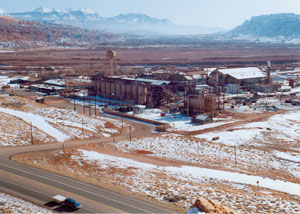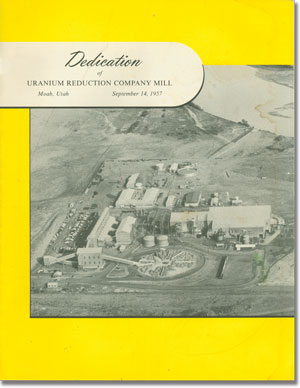While work progresses on removing a 16-million-ton radioactive dump out of the Moab Valley, community developments that the defunct uranium plant once enabled as the biggest taxpayer in Grand County are also being removed or upgraded.
 Winter scene of the Uranium Reduction Company Mill (Atlas Minerals plant) north of Moab in 1988, prior to its dismantling. Photo by Vicki Barker.
Winter scene of the Uranium Reduction Company Mill (Atlas Minerals plant) north of Moab in 1988, prior to its dismantling. Photo by Vicki Barker. |
The Uranium Reduction Company mill -- more commonly remembered as the Atlas Minerals plant -- declared Moab “Uraniumland” 52 years ago this month in a booklet distributed at the dedication of the largest processing plant of its type in Utah. The plant was built on 50 acres adjacent to the Colorado River at the northern gateway to Moab.
National focus on how the company’s penniless petroleum engineer Charlie Steen became a multi-millionaire after discovering a huge deposit of uranium ore near Moab fed fantasies of others across the country to strike it rich and created a frenzy remembered as the Uranium Boom.
The Steen story and government demand for uranium to develop an atomic arsenal drew thousands of prospectors and their families to rural Moab, at the time a village of some 300 people. Life was rough and times were tough for many in the Atomic Era that followed the rush of 1952. Some profited, others failed.
By the time the mill was completed and formally dedicated in September 1957, URECO proudly pointed to progress that had come with the industry: Besides employing 220 people, the $9 million plant contributed substantially to the local and state economy, including development of a new hospital, courthouse, swimming pool, and two elementary schools in Moab.
Today, plans are underway for building new school facilities, several new pools, and a new hospital; the county courthouse was expanded in the 1990s and seeks to further expand; and the mill tailings plant -- dismantled and removed after shutting down in 1984 -- is now site of a federal Uranium Mill Tailings Remedial Action (UMTRA) project that ultimately could cost $1 billion.
In April, the U.S. Department of Energy began hauling the processed uranium tailings by train to a desert repository site north of Crescent Junction. Officials targeted 2019 for complete removal of the pile, but it may take until 2025. The American Recovery and Re-investment Act (the economic stimulus bill) designated $108 million to the project to help speed up the work and hire more people. Currently, the project employs some 200 people.
More recently, citizens of Moab and Grand County were recognized in a Southern University Rural Honors Award for more than a decade of efforts to ensure the government removed the toxic waste pile, which had slowly been leeching contaminants into the nearby river. While the former Nuclear Regulatory Commission had favored “capping” the tailings in place, locals prevailed in a campaign that resounded in Washington, D.C. to have the contaminants removed.
 Dedication program booklet image courtesy of URECO
Dedication program booklet image courtesy of URECO
and private collection of D. Barker |
In August, the stimulus funds boosted the pace of the removal project to begin hauling the processed ore in two daily train runs utilizing 22 cars. The load is to increase to 34 cars daily by November, according to DOE officials.
As for the other developments that uranium brought to Moab, the city tore out the old swimming pool in August, following conclusion of years of negotiations between Moab and the Grand County Recreation Special Service District . The agreement will result in a $6.8 million recreation and aquatic center with three new pools (one offering year-round swimming indoors) by the fall of 2010.
In late August, a groundbreaking ceremony on 12 acres heralded construction of a new hospital on the corner of Williams Way and 500 West. Fate of the old Allen Memorial Hospital on 400 North is still up in the air, although demolition is likely because of the exorbitant cost of bringing the building up to code for any other use.
The new $29 million facility will include a 17-bed state-of-the-art hospital run by Moab Valley Health Care, and a 32-bed long-term care unit operated by the Canyonlands Health Care Special Service District. Opening is expected in late 2010 or early 2011.
Construction of two new school buildings is underway. The public approved a $31 million bond issue, with $7 million designated for a vocational center next to Grand County High School, scheduled to open in August 2010. A new two-story school to accommodate 800-900 students of all ages will tower over the old Helen M. Knight elementary school. The old HMK, built in 1955, will be demolished, but the new school will retain the name of the school district’s first superintendent, who wrung her hands over schools bulging with all the new students arriving with prospector parents. Enrollment had risen from 300 to 2,000 students in only five years, according to the book, “Grand Memories” (Daughters of Utah Pioneers).
A wing of a second elementary school, between Mill Creek Drive and Locust Lane, was built the same year as URECO formally opened the uranium processing plant. A bond issue passed in 1961 to provide for the second school and a shop at the junior high school (Eventually, the shop was demolished to make way for the new county library.). The new Southeast Elementary School -- eventually renamed Red Rock Elementary -- opened with double sessions to accommodate all the children. Some went to school in early morning, and others started school in the afternoon.
Upon completion of the new school behind HMK, Red Rock could serve as a middle school but is also being considered as a secondary campus site for the College of Eastern Utah and Utah State University.
The historic courthouse built during the Uranium Boom suffered extensive smoke damage in a fire that started in the jail area in the early ’90s. In 1991-92, the county rebuilt the jail section, expanded the courts portion, added the county council chambers, and remodeled the original structure to accommodate clerk and administrative offices.
More than a half-century after the Atlas plant was built and referred to as a “symbol of…growth and stability” in Moab, what remains of the fruit of the uranium harvest will mostly be rubble, but it has given rise to new development in a town holding stable at 4,800 people. |

